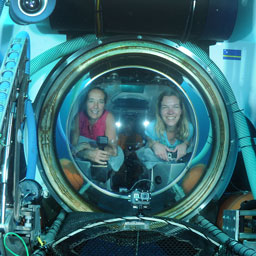
Support Ichthyology
Your gift makes it possible! We couldn't do what we do without generous donor support for collections care, research and public outreach.
This information is provided for people interested in having a fish specimen identified by the Burke Museum Ichthyology Collection or in donating a fish specimen to the collection.
Before any collecting can be done, the collector or collecting party must obtain the proper permits from the appropriate local, state or federal agencies. Contact us before any collecting is done to be sure the proper permits are in place.
Frozen fishes may be brought to the Ichthyology Collection but formalin fixation is highly recommended for all routine collections (specimens destined for certain specialized studies such as histological work may be fixed in various other ways). Specimens should first be killed by means of a chemical anesthetic such as MS-222, or a similarly acting substance.
If possible, a small piece of muscle tissue or a fin clip from either a pelvic or pectoral fin should be removed and placed in a small vial of 95% ethanol. If this tissue sample is not taken before fixing the specimen in formalin, no genetic information will be available from the specimen. Take care to label the tissue sample so that it is clear which specimen it comes from.
Specimens should then be placed in a solution of formalin made up of one part commercial formaldehyde and nine parts water. This solution is of sufficient strength to fix small fishes up to 15 cm in length in about three days, but larger specimens should remain in the solution for a greater length of time depending on their size. Specimens over 10 cm in length should be slit in the belly with a sharp knife or scissors, or they should be injected (with a syringe or hypodermic) with formalin. This allows the fixative to enter the body cavity and keep the contents from spoiling. In addition, the body musculature of large fishes (i.e., specimens 30 cm or more in length) should be injected about every 5 cm or so to allow the fixative to reach the deepest parts, and the specimens should be left in formalin from five to seven days or more. After that time, they should be passed through several changes of water, over a period of two or three days, to wash out the formalin, and then placed in 70% ethyl alcohol for preservation. Remember to be careful when using formalin—it's nasty stuff. Also remember not to pour formalin down the drain. It must at all times be disposed of according to rather strict state guidelines.
Labels, giving all essential data, should be placed in the jar with the fishes when collected. Accurate information about the locality is as valuable as the specimens themselves; specimens without proper data are of little scientific value.
Labels should have at least the following information: exact locality, coordinates, nearest land mass, or reference to a town commonly appearing on maps, date collected, name of the collector, and any other information that seems pertinent, such as depth of water, method of capture any and all ecological data, etc.
Labels should be written with a soft lead pencil or permanent black ink (e.g., a Rapidograph pen) on 100% cotton or linen paper. Do not use ordinary paper because it will disintegrate in the liquid. Do not use a ball-point pen—the ink in most cases washes off in a matter of days.
Large fishes may be tagged, preferably through the lower jaw, with all essential data written on the tag, or a number may be used and the data recorded under the identical number in a notebook. Always keep a field notebook in which you record all the information about each collection made.
Questions?
Contact Us

Your gift makes it possible! We couldn't do what we do without generous donor support for collections care, research and public outreach.